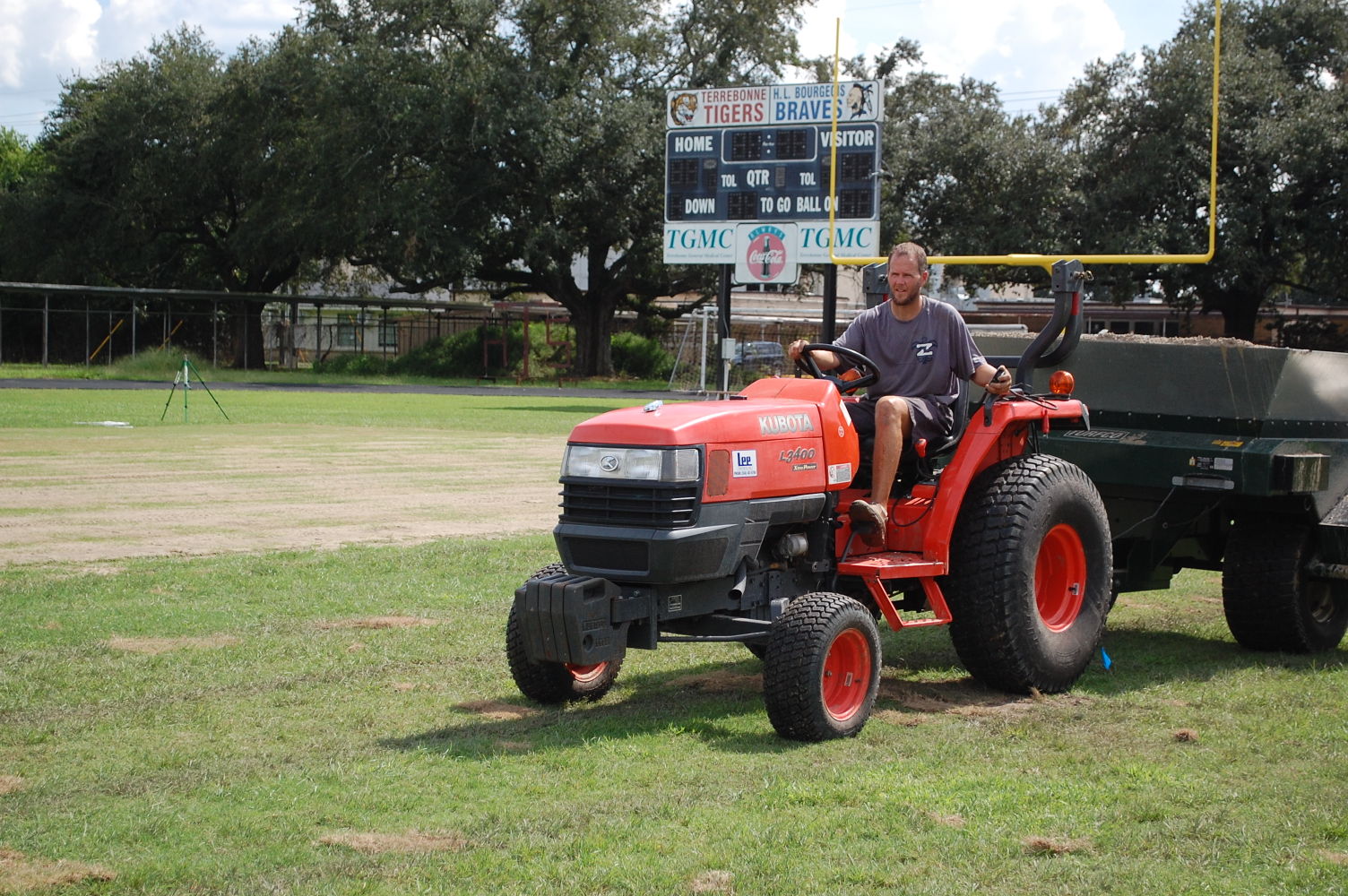
Houma portraitist Boudreaux captures ‘furry’ personalities
October 14, 2014Our kids deserve field turf
October 14, 2014Last week, the Terrebonne Parish School Board took a step in the right direction, according to the opinions of many.
With concerns growing regarding the reliability of Terrebonne Parish’s public school football fields, the school board decided without opposition last Tuesday to authorize Superintendent Philip Martin and his staff to gather information regarding the possible installation of field turf at Terrebonne and South Terrebonne high schools.
Martin and his staff will report their findings to the Buildings, Food Service and Transportation Committee Dec. 8.
“I’m not an expert on artificial turf. I don’t think any of us are. It’s a fact gathering mission,” Martin explained. “I don’t know much about artificial turf. I know you don’t have to water it. I know you don’t have to cut it. That’s about it.”
He added that he and his staff will contact people knowledgeable about field turfs and ask general questions regarding cost, durability and the pros and cons involved.
It’s a move that school board member Greg Harding is happy he and his cohorts moved forward on.
“The football field at Terrebonne and South Terrebonne is part of our maintenance. So it’s not just about saving money. It’s about putting the best product out there so you can have no injuries and have a mud bowl again, so it’ll just be better play of ball,” Harding said.
The mud bowl Harding alluded to happened several weeks ago when rain and muddy conditions plagued H.L. Bourgeois’ home-opener versus South Terrebonne Sept. 5, rendering the field unplayable.
H.L. Bourgeois and Terrebonne, of course, share a home stadium on the campus of Terrebonne High School.
The Terrebonne Parish School Board then spent $10,000 to re-sod the field – placing a Band-Aid, so to speak, on a much larger issue. With the junior varsity games being moved on the road permanently, H.L. and Terrebonne moved a varsity home game each to South Terrebonne’s stadium until the schools could resume play at Terrebonne in late September when the re-sodding had settled in.
That, of course, put more strain of South Terrebonne’s field – one that was already slated to feature 20 football games and about 16 soccer games this year thanks to it too housing contests featuring two public high schools – South Terrebonne and Ellender.
“By the time we get into the first couple of soccer games, they’re to be playing on dirt basically by that time,” South Terrebonne Athletic Director Francis Labat said while also stating that head football coach Richard Curlin does a great job keeping the field up.
For obvious reasons, many felt action needs to be taken in Terrebone Parish – like it has been taken in other nearby areas in regard to the instillation of field turf.
“My look at it is look at the trend that surrounds us, Hahnville, the E.D. White, St. James, all the other schools are going toward artificial turf, and the reason why is because you’re talking about 10 to 12 years of fields,” Harding said. “You don’t have to worry about the wear and tear. You don’t have to worry about cutting grass. You don’t have to worry about bad weather or losing any games or anything.”
Field turf instillation requires about a $600,000 to $800,000 one-time cost and usually lasts between eight and 15 years. That means that if the school board chooses to install field turf at both Terrebonne and South Terrebonne high schools, it would likely cost well over $1 million up front.
Because the foundation is permanent and only the top layers need to be replaced, when it comes time to change carpets, the price is much more manageable than the up front one.
Compare that to constant upkeep of grass fields and the headaches that they present, and the installation of field turf could save the school district money in the long run. But even if it ends up being more expensive, Harding said it’s the right move for the kids of the area. However, he doesn’t want to rush the process.
“When you’re talking about spending taxpayer dollars, about $1.2 million on football fields, you better make sure that you cross all your t’s and dot all your i’s,” he said.
Money aside, the most important factor in the decision-making process boils down to player safety.
As with just about anything else, there’s conflicting published data regarding the safety of field tuft fields compared to grass fields, although most long-term comprehensive research points toward better player safety on field turf fields. Check out Casey’s Corner below for some specifics.
Covenant Christian Academy head football coach Randy Boquet has experience on both – coaching at H.L. Bourgeois and South Terrebonne for the better part of two decades and now playing his home games at Nicholls’ John L. Guidry Stadium featuring field turf.
“As far as injuries, I personally haven’t seen any real differences between the two,” Boquet said. “Unfortunately I’ve seen kids get hurt on both fields. I don’t think turf is better or worse when it comes to injuries as far as ankles or knees or anything. I would imagine that the grass field would be softer as far as impact as opposed to a turf field, but as far as major injuries I haven’t seen any real difference between the two.”
That’s where the similarities end, however, according to Boquet.
“As far as playing ability, like it’s a wet day. It’s a rainy day. There’s no comparison. You want the turf over the grass. You have a nice humpback turf field and within minutes of playing it’s good to go whereas if you’re on a grass field depending on how good the turtle back is, if you’re lucky it’ll just be sloppy. If you’re unlucky, it’ll almost be unplayable,” Boquet explained. “… As far as convenience goes, I’m not sure there’s any question that a turf field that’s already lined off for you would be a tremendous bonus and benefit for a coach. It would be a whole lot more convenient not to have to display game field lines every week and marking the field two or three times a year, that would be a huge advantage there and just overall maintenance, there’s no question between the two, field turf wins hand down.”
Boquet half-heartedly joked that he’s jealous that Terrebonne public schools didn’t consider field turf fields when he was there and if a super-duper rich person wants to give CCA one, he’d be 100 percent behind it.
“I think it should happen. I really do. They’re really going to benefit a lot from this if it does happen,” he said.
As for funding, Harding mentioned the general fund, as well as many building site roof projects coming to an end possibly freeing up funds. He also wondered if oil and gas companies operating locally might be willing to donate the fields to our area high schools.
“There’s all kinds of ways, and I think if there’s a will, there’s a way,” Harding said. “If you want something bad enough, you’re going to make it work.”
— richard@rushing-media.com
No. 7 Lafourche moves on field turf
It was a wet summer in Louisiana, which devastated area playing fields – a now seemingly routine occurrence in the Houma-Thibodaux area.
South Terrebonne High School’s field got it the worst. They played a game against Bonnabel during a driving rain storm, which damaged the field so badly that Ellender had to move its home game the next week to Patterson High School.
Another game between Central Lafourche and Thibodaux High was played in difficult conditions, which coaches speculate led to several sprained ankles and leg injuries during the game.
But help is seemingly on the way – at least in Lafourche.
The Lafourche Parish School Board is asking voters to renew a facilities millage, which they’d then use to put turf on the parish’s three fields.
That vote will come in 2017, but is widely expected to pass, because it is not a new tax for citizens.












